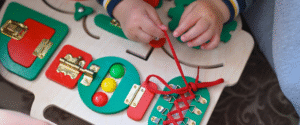
EYES ON THE PRIZE
– THE POWER OF HAND-EYE COORDINATION FOR MASTERING FINE MOTOR SKILLS
From playing catch to mastering the art of drawing, hand-eye coordination is the superhero skill that enables children to develop their fine motor skills with ease.
Have you noticed the stage within a child’s life where their messy scribbles become somewhat legible pictures? Or that they catch a ball much easier? Or that they stack the block tower higher before it falls?
All of these changes can be partly due to the development of fine motor skills, but also other skills such as hand-eye coordination.
So, when children are referred to occupational therapy for fine motor skills, it is important we look not only at the strength of the hand but other factors that may influence fine motor development.
Hand-eye coordination refers to the ability of the hands and eyes to work together to perform a task. It involves the visual system, providing visual information to the brain about the location of objects and the movements required to interact with them, as well as the motor system, which executes the movements needed to manipulate objects.
Children who have poor hand-eye coordination may:
- Struggle catching or throwing a ball.
- Have difficulty writing or drawing, or be resistant to do such tasks.
- Prefer to use their hand rather than using utensils.
- Be clumsy or awkward in movement, such as bumping into objects or knocking things over frequently.
- Have poor posture or balance.
- Have difficulty with visual tracking, such as following moving objects or tracking a line of text while reading.
- Not be able to do up their shoelaces or button up clothes like other children their age.
It’s common for children who struggle with sensory processing difficulties to experience difficulties with hand-eye coordination and, therefore, fine motor skills. For example, children with sensory processing difficulties may find seeing things with their eyes hard, such as where the pencil is on the page, or where the ball is in relation to the bat. Without this visual feedback, they can have challenges getting their body ready to move so that they can hit the ball or draw the wheels on the car. This is how hand-eye coordination can impact their ability to develop their fine motor skills.
How can we work on Hand-Eye coordination?
Providing sensory-rich environments through activities such as playing with playdough, finger painting, lego, and puzzles can help children develop their sensory processing skills and improve their hand-eye coordination. We also look for opportunities for movement and physical activity, as this can help children learn where their body, arms and legs are so they can move or adjust their bodies to be ready for what is to come. Once we know where our body, arms and legs are, we then know where our wrists, hands and fingers are. Combining that with our eyes telling our body what is coming means we can coordinate our hands and eyes to complete the task in front of us.
Some ways your child can develop hand-eye coordination at home:
- Stringing beads or threading pasta
- Throwing and catching a ball, balloon, or frisbee
- Jigsaw puzzles
- Drawing and colouring
- Using scissors, cutting out and then pasting onto a page
- Playing with blocks or Legos (We would love to see the creations made!)
- Playing with Play-Doh
- Play with Play-Doh: Use their hands to manipulate the dough while looking at what they are making
We hope you have found this blog informative; if you need a ‘hand’ with developing your child’s Hand-Eye Coordination, please call us today; we would love to chat about what we can do to support your child’s development.
Looking forward to hearing from you soon. Contact us on 0477 708 217 or admin@exploreandsoar.com.au
Until next time,
Molly
ORIGINALLY PUBLISHED JULY 5, 2023






